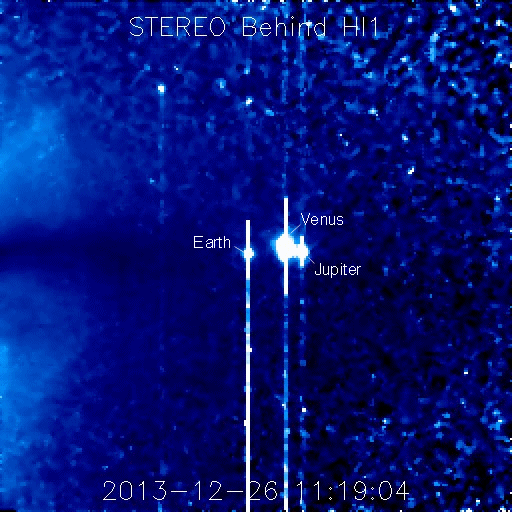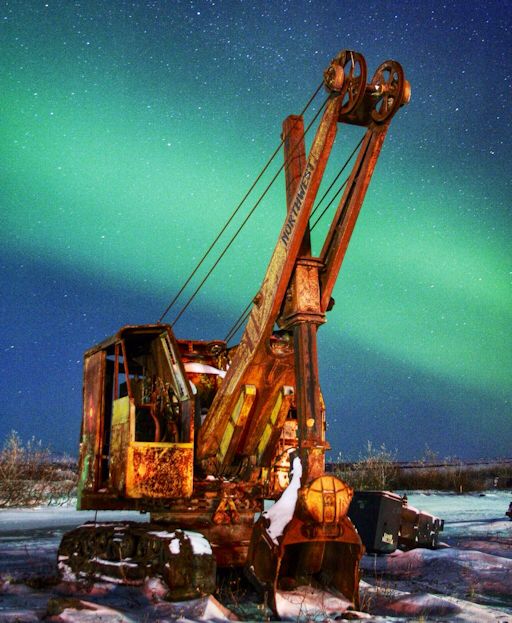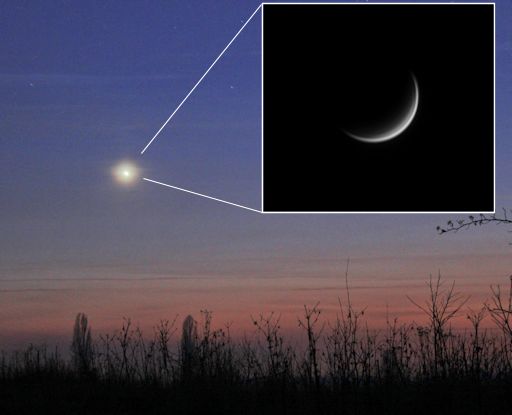When is the best time to see auroras? Where is the best place to go? And how do you photograph them? These questions and more are answered in a new book, Northern Lights - a Guide, by Pal Brekke & Fredrik Broms. | | |
SLIGHT CHANCE OF FLARES: Sunspot AR1934 has a 'beta-gamma' magnetic field that harbors energy for M-class solar flares. Because the region is directly facing Earth, any flares today would surely be geoeffective. The sunspot has been relatively quiet for days, however, so NOAA forecasters are estimating only a 25% chance of M-flares. Solar flare alerts: text, voice.
CHRISTMAS CONJUNCTION CONTINUES: Christmas is over, but the amazing "Christmas conjunction" is still underway. As seen from NASA's STEREO-B spacecraft, the three planets Venus, Earth and Jupiter are clustered in a circle barely 2 degrees wide. The spacecraft's Heliospheric Imager took this picture on Dec. 26th:

Because of the holidays, this conjunction in space raises comparisons to a famous Christmas conjunction on Earth. According to some scholars, the Star of Bethlehem might have been a close encounter between Venus and Jupiter. The two brightest planets in the night sky, merged, would have made a spectacle so amazing that we still talk about it ~2000 years later.
Unlike conjunctions of the distant past, this one includes our home planet. STEREO-B is located on the far side of the sun where it can look back and see Earth along with other worlds in the Solar System. From STEREO-B's point of view, Jupiter and Venus about 0.5 degrees apart. That is not nearly as tight as the putative Star of Bethlehem conjunction when those two planets were separated by as little as 6 arcseconds (0.00166 degrees). Nevertheless, the Christmas conjunction of 2013 is special because it includes Earth--the first time in history such a conjunction is possible. Happy holidays from STEREO!
Realtime Space Weather Photo Gallery
CHRISTMAS LIGHTS: Skies above the Arctic Circle turned green on Dec. 25th when the interplanetary magnetic (IMF) field near Earth turned south. This opened a crack in our planet's magnetosphere. Solar wind poured in and fueled a display of Northern Lights:

:"I saw these at 8:30 am on Dec. 25th," says photographer John Dean of Nome, Alaska. "They were the first Christmas auroras I have ever seen."
The day after Christmas could be good, too. A solar wind stream is expected to brush past Earth's magnetic field on Dec. 26th, prompting NOAA to estimate a 35% chance of polar geomagnetic storms. High-latitude sky watchers should remain alert for auroras. Aurora alerts: text, voice.
CRESCENT VENUS: Wondering where to point that telescope you got for Christmas? Here's a target that will blow your holiday socks off: Venus. Like the Moon, Venus has phases, and at the moment it is a slender crescent. Maximilian Teodorescu sends this Christmas Eve photo from Targoviste, Romania:

"I enjoyed another superb sunset with Venus dominating the southwestern sky," says Teodorescu. "The bright planet was visible even through cirrus clouds. Despite poor seeing conditions, the view through my refracting telescope was superb both at 30x and at 200x."
Every night the crescent grows thinner as Venus moves toward inferior conjunction with the sun in early January. Tonight, only 10% of the planet's illuminated hemisphere is visible from Earth. Because Venus is so thin, refraction in our atmosphere can produce a rainbow effect as colorful as any Christmas ornament. It really is a magical sight. More information is available from Sky and Telescope.
Realtime Venus Photo Gallery
Realtime Aurora Photo Gallery
Realtime Comet Photo Gallery
Every night, a network of NASA all-sky cameras scans the skies above the United States for meteoritic fireballs. Automated software maintained by NASA's Meteoroid Environment Office calculates their orbits, velocity, penetration depth in Earth's atmosphere and many other characteristics. Daily results are presented here on Spaceweather.com.
On Dec. 26, 2013, the network reported 24 fireballs.
(21 sporadics, 3 December Leonis Minorids)

In this diagram of the inner solar system, all of the fireball orbits intersect at a single point--Earth. The orbits are color-coded by velocity, from slow (red) to fast (blue). [Larger image] [movies]
Potentially Hazardous Asteroids (
PHAs) are space rocks larger than approximately 100m that can come closer to Earth than 0.05 AU. None of the known PHAs is on a collision course with our planet, although astronomers are finding
new ones all the time.
On December 26, 2013 there were potentially hazardous asteroids.
Notes: LD means "Lunar Distance." 1 LD = 384,401 km, the distance between Earth and the Moon. 1 LD also equals 0.00256 AU. MAG is the visual magnitude of the asteroid on the date of closest approach. | | The official U.S. government space weather bureau |
| | The first place to look for information about sundogs, pillars, rainbows and related phenomena. |
| | Researchers call it a "Hubble for the sun." SDO is the most advanced solar observatory ever. |
| | 3D views of the sun from NASA's Solar and Terrestrial Relations Observatory |
| | Realtime and archival images of the Sun from SOHO. |
| | from the NOAA Space Environment Center |
| | the underlying science of space weather |

